
Southington is a town in Hartford County, Connecticut, United States. As of the 2020 United States Census, it had a population of 43,501. Southington contains the villages of Marion, Milldale, and Plantsville.

The Saxony Mill was a historic textile mill complex at 66 West Street in Rockville section of Vernon, Connecticut. With a construction history dating to 1836, it was one of the oldest surviving wood-frame textile mills in the state prior to a 1994 fire which led to its demolition. The mill complex was added to the National Register of Historic Places in 1983.

The Wilcox, Crittenden Mill, also known as Wilcox, Crittenden Mill Historic District, is a 17-acre (6.9 ha) property in Middletown, Connecticut that was listed on the National Register of Historic Places in 1986. It was the location of the Wilcox, Crittenden company, a marine hardware firm. The historic district listing included four contributing buildings and three other contributing sites.

The Colt Armory is a historic factory complex for the manufacture of firearms, created by Samuel Colt. It is located in Hartford, Connecticut along the Connecticut River, and as of 2008 is part of the Coltsville Historic District, named a National Historic Landmark District. It is slated to become part of Coltsville National Historical Park, now undergoing planning by the National Park Service.
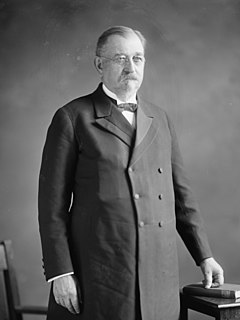
Marcus H. Holcomb was an American politician and the 66th Governor of Connecticut.
Newhallville is a neighborhood in the city of New Haven, Connecticut, named for industrialist George Newhall.

The American Waltham Watch Company Historic District encompasses the former factory of the Waltham Watch Company, the leading American watch manufacturer of the 19th century and the city's largest employer. Located on Crescent Street and the banks of the Charles River, the surviving elements of its manufacturing facility date from the 1870s to the 1910s, and include particularly fine industrial Romanesque architecture. The buildings have been converted to a variety of commercial, industrial and residential uses since they ceased being used for watchmaking in the 1950s. The complex was listed on the National Register of Historic Places in 1989.
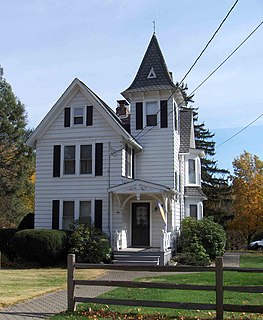
Marion is a neighborhood in the town of Southington in Hartford County, Connecticut, United States. It is generally the area in the vicinity of the intersection of Route 322 and Marion Avenue just north of the Cheshire town line.
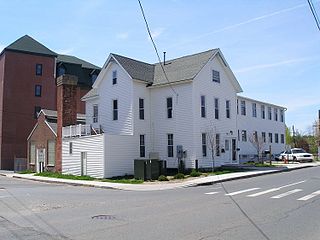
The Ball and Roller Bearing Company, also known as American Family Crafts and the Joseph Nutt House and Machine Shop, is a historic industrial complex at 20-22 Maple Avenue in Danbury, Connecticut. Developed mainly in the early 20th century, the factory is most notable as the location where Lewis Heim invented the modern grinding machine, which revolutionized the manufacture of machine parts. The complex was listed on the National Register of Historic Places on August 25, 1989. It now houses a church and social service agencies.
Wilcox Building may refer to:

The Atwater Manufacturing Company is a historic industrial property at 335 Atwater Street in Southington, Connecticut. The company, founded in 1867 and now known as Rex Forge, has long been one of Southington's major industrial employers. The ten extant buildings of the complex date as far back as 1912, and are an important element of the town's industrial past. The property was listed on the National Register of Historic Places in 1988.

The Blakeslee Forging Company is a historic industrial complex at 100 West Main Street in the Plantsville area of Southington, Connecticut. The surviving six buildings, dating to about 1910 or later, were developed for a company founded in 1877 that specialized in drop forging. The buildings are well preserved structures typifying industrial buildings found in Southington from that era. The complex was listed on the National Register of Historic Places in 1988.

The Clark Brothers Factory No. 1 was a historic industrial complex at 1331 South Main Street in the Milldale area of Southington, Connecticut. Developed beginning in the 1850s, it was one of the nation's largest sources of carriage bolts. The complex listed on the National Register of Historic Places in 1988 consisted of a group of brick buildings dating to 1893 and later. It has since been entirely demolished, and the land stands vacant and overgrown.

The Clark Brothers Factory No. 2, also known as Clark Brothers Bolt Company, is an industrial complex at 409 Canal Street in Southington, Connecticut. Built between 1911 and 1918, the complex is a good example of vernacular industrial architecture of the early 20th century, and was home to one of the community's major industrial employers. The complex was listed on the National Register of Historic Places in 1988.

The Hurwood Company is a historic industrial complex at 379 Summer Street in Southington, Connecticut. Built beginning sometime before 1884, this complex of mainly brick buildings is typical of the town's industrial landscape of the late 19th and early 20th centuries, and was where solid-headed screwdrivers were first manufactured. The complex was listed on the National Register of Historic Places in 1988.
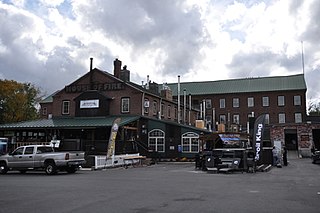
The Pultz & Walkley Company, also known more recently as The Five Star Company, is a historic industrial complex at 120 West Main Street in the Plantsville village of Southington, Connecticut. Founded in the 1870s, Pultz & Walkley was a major producer of paper bags. The multi-building complex is one of the town's better-preserved industrial properties, and was listed on the National Register of Historic Places in 1988.

The H. D. Smith Company Building is a historic industrial building at 24 West Street in Plantsville, Connecticut. With a construction history dating to 1882, it is one of the more architecturally interesting examples of Southington's industrial architecture, and was home to H. D. Smith & Co. from construction to the 1920s. It was listed on the National Register of Historic Places in 1977.
Orson William Stow was an American manufacturer and state legislator.
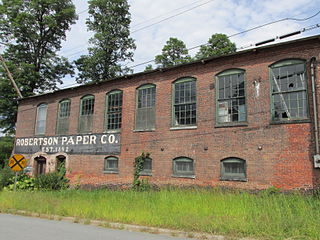
The Robertson Paper Company Complex was a historic industrial facility on Island Street in Bellows Falls, Vermont. It consisted of a collection of mostly-interconnected factory and related buildings, built between c. 1890 and c. 1960 by various paper-related companies. It was occupied and enlarged by the Robertson Paper Company between 1907 and its failure in 1987, at which time it was the longest-lived paper company in the state. The complex was listed on the National Register of Historic Places in 1990. It was demolished in 2018-19 as a Brownfields Economic Revitalization Alliance (BERA) project, with federal, state, and local funding.

The Matthews and Willard Factory was a historic industrial site at Cherry Avenue and North Elm Street in Waterbury, Connecticut. Founded in 1874, Matthews and Willard contributed to the expansion of Waterbury's brass processing industry. The plant remained little altered from its last period of expansion c. 1900, and was a good example of period industrial architecture. It was listed on the National Register of Historic Places in 1988, and was demolished in 2012. As of 2018, the site stands vacant.




















